New York’s Once-booming Oil Industry and the Risky Wells It Left Behind
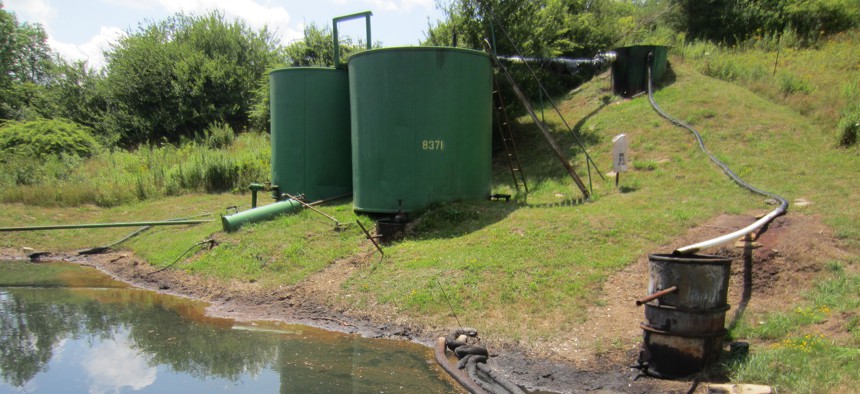
Oil wells photographed by environmental activist Walter Hang. Walter Hang
Western New York towns were built around oil production. Now, they’re grappling with the remnants of a declining industry.
When Paul Plants and his business partner started their oil company in 1970, they never expected to profit from the fossil fuel industry’s decline. “It’s an industry that is – was – very important,” Plants said. “I’m very proud of our involvement in it.”
Plants’ father had worked in oil, and Plants himself, now 84, started his own drilling company in New York and Pennsylvania, the historic centers of oil drilling in the U.S.
Faced with both declining output and shifting opinions on oil and gas in New York roughly four decades later, Plants needed to pivot. Instead of drilling for oil, Plants & Goodwin began plugging abandoned oil wells throughout the Northeast. Plants’ son and grandson took over the business and continue that work today.
Allegany County, the former seat of oil production in New York, now has more abandoned and unplugged wells than active wells. Left open and unchecked, the Environmental Defense Fund said unplugged wells can cause air pollution, contaminate groundwater and release greenhouse gases. Despite up to $70 million available to New York to plug abandoned wells from President Joe Biden’s 2021 infrastructure package, oil companies and environmental advocates said the state’s resources fall far short of the need.
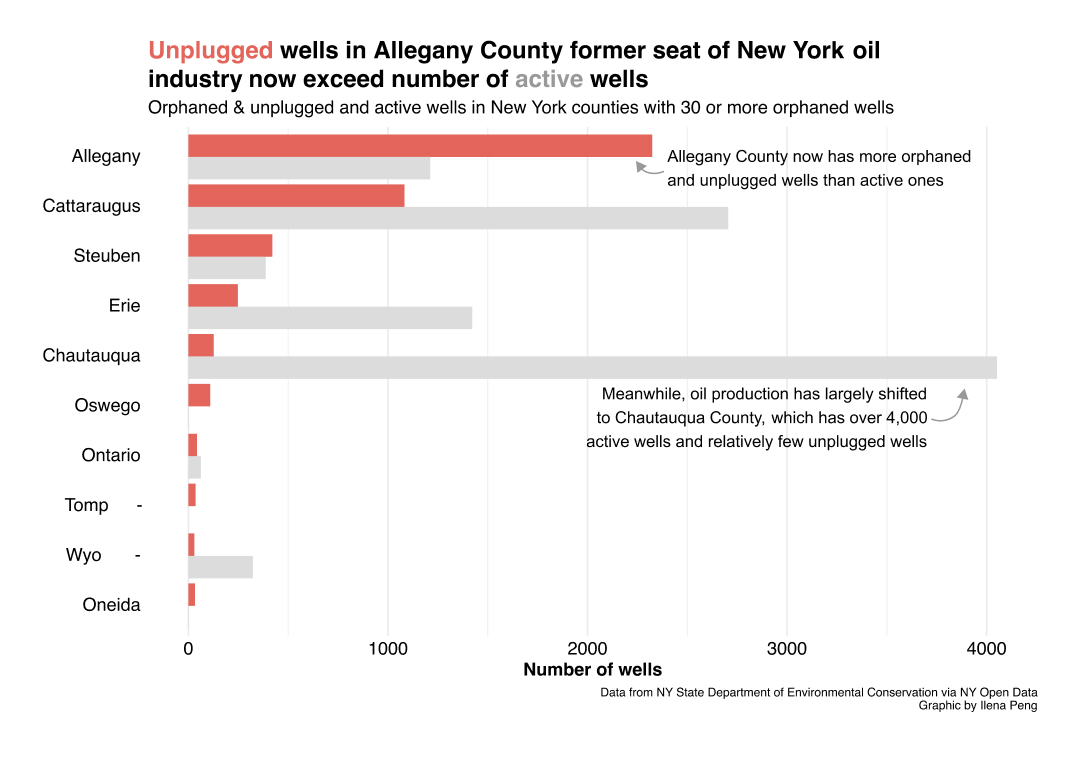
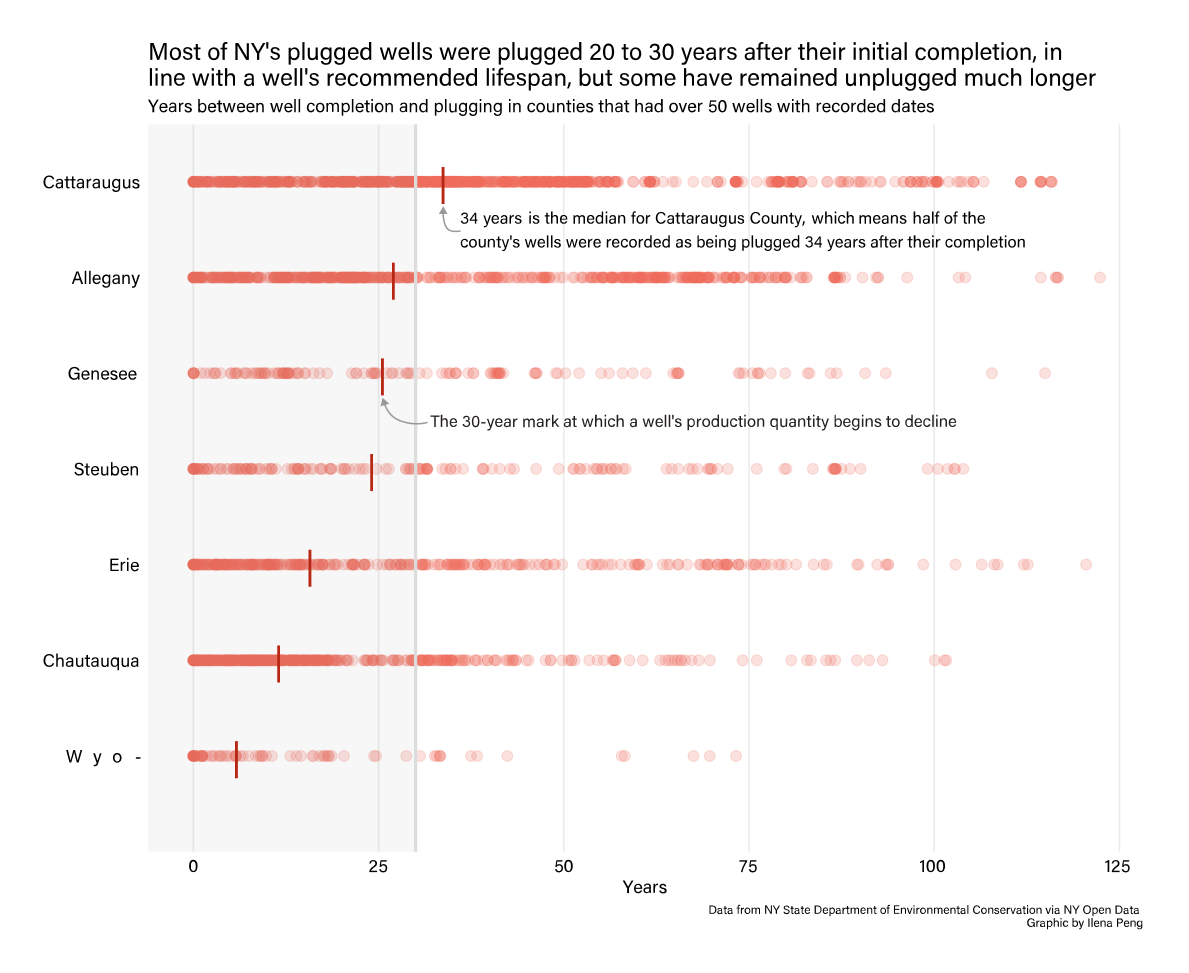
Though Texas, New Mexico and North Dakota are the modern hubs for U.S. domestic oil drilling, western New York is home to some of the country’s first oil wells. At its peak in 1882, New York state produced 6.7 million barrels of oil, more than 6 million of which came from a single county: Allegany.
New York experienced an “oil rush” in the late 19th century. Small towns grew by the thousands, and oil quickly became the foundation of the local economy. Its run, however, was short-lived. Aside from an uptick in production during World War II – when Plants’ dad was drafted, but he was able to defer enlisting because his job in the domestic oil industry was deemed essential to the war effort – oil output in New York declined and thousands of wells, some over a century old, were left behind with no existing owner of record. In New York, the responsibility of plugging these “orphaned” wells fell to the state Department of Environmental Conservation.
Since 2014, the department has plugged about 360 abandoned and orphaned oil and gas wells. The state has records for roughly 7,300 orphaned wells. Of these, only 2,588 have been located by the department. As of a 2018 estimate, an additional 34,000 orphaned wells exist in the state that no one has been able to locate. These wells dot private properties, lurk in wetlands and hide beneath forest canopies, presenting potential environmental and safety risks for the state and the people who live nearby. Allegany and Cattaraugus counties account for 74% of the state’s documented abandoned and unplugged wells.
While the infrastructure package should boost efforts to plug these wells in New York, the state won’t get everything it asked for, according to Adam Peltz, senior attorney for the Environmental Defense Fund.
“There are so many problematic orphaned wells that existing funding will barely even cover those,” he said in March.
In early 2021, the department announced plans to enlist drone and magnetic surveillance technology to spot undocumented abandoned wells – a project funded by $400,000 from the New York State Energy Research and Development Authority. The department said it hoped to be operating the technology this summer.
The problem of abandoned oil and gas infrastructure is not unique to New York. While oil drilling in the U.S. began in the 19th century, regulations weren’t passed until the early to mid-20th century. There are roughly 3.2 million abandoned oil and gas wells nationwide, many of which were left behind by drilling companies that have since gone out of business.
“Many wells that are now orphaned were drilled before there was any regulatory oversight,” according to a 2019 report by the Interstate Oil and Gas Compact Commission. “Many of these pre-regulatory wells were abandoned without being plugged or were plugged inadequately.”
That’s also true of western New York, where commercial oil drilling began in 1865 and took off in the late 19th century. According to the department, the state passed legislation requiring abandoned wells to be plugged “to prevent freshwater contamination by oil and gas” in 1879, but the legislation carried “no strong enforcement mechanism.” While the state has been concerned with the environmental consequences of drilling since the industry’s infancy, over a century of lax enforcement has modern-day consequences.
An Environmental Protection Agency 2020 report said abandoned oil and gas wells across the country were responsible for 281 kilotons of methane emissions in 2018, the equivalent of the annual greenhouse emissions from more than 1.5 million cars. Catherine Dickert, director of the Department of Environmental Conservation’s Division of Mineral Resources, said: “Plugging abandoned wells is one of many actions New York state is taking to reduce methane emissions.”
Unplugged wells are also known to leak oil, saline water and other fluids into the air, groundwater and surface water. According to a 2021 paper in Elementa: Science of the Anthropocene, leaks from abandoned wells can cause “air pollution, greenhouse gas emissions, groundwater contamination, soil degradation, damage to ecosystems, and risk of explosions, all of which pose threats to human health.”
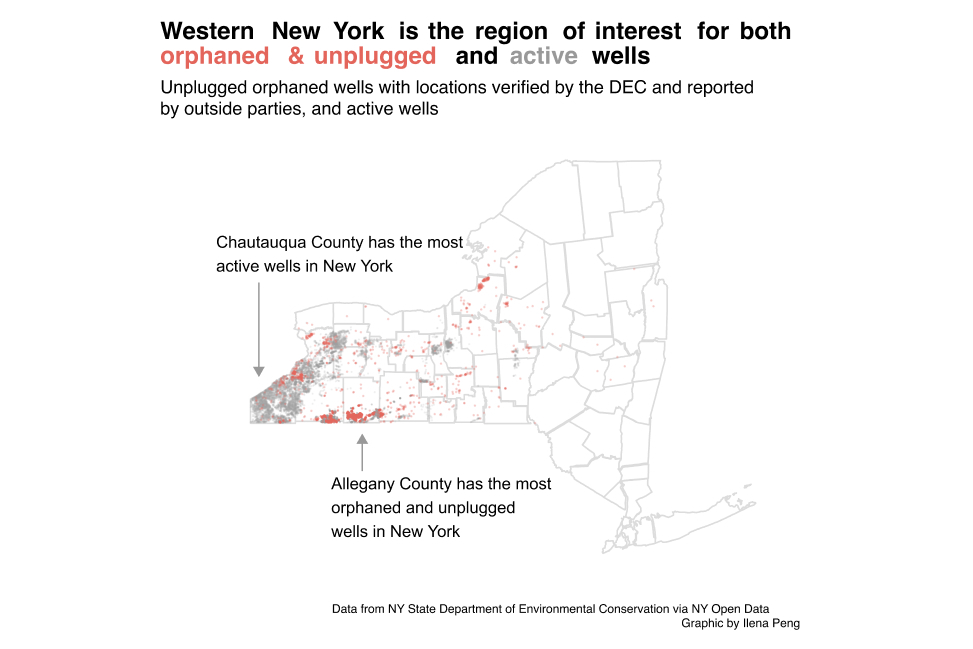
Plants & Goodwin represent one of a handful of niche companies contracted by states or other oil companies to plug wells in the Northeast. Plants, who lives on the same large farm where he grew up, said contractors plugged the 80 abandoned wells on his land in Pennsylvania’s McKean County, which is just southwest of New York’s Allegany County.
“It grieves me a little bit that people who made lots of money in the early days did not take care of the wells and (plug) them,” Plants said. “But it’s vitally important that it gets done.”
Peltz said new federal funding and an uptick in awareness of abandoned wells marks a key opportunity for the state. He said New York must make progress on plugging documented abandoned wells, while also enacting policy changes to ensure newly inactive wells are plugged by the industry.
As the era of oil drilling comes to an end in New York, hundreds of active wells are decommissioned every year. According to the Canadian Association of Petroleum Producers, the useful lifespan of a well before it gets plugged is about 30 years. But some wells in New York remain open, unplugged and inactive for much longer. One well in Oswego County, which borders Lake Ontario, was completed in 1890 and was plugged in 2019.
Walter Hang, an environmental activist who has for decades been at the forefront of conservation efforts in the state Legislature, explained that as oil companies left the state or shut down, they either neglected to plug the wells they left behind or went out of business before they could address the problem.
“The number of active production wells went down, down, down,” he said. “They play out, and in theory, they get abandoned and get plugged.”
Today, New York’s oil production is almost negligible. Oil output in New York actually increased from 2018 to 2019, but the state produced only about 277,000 barrels of oil in 2019. By comparison, Texas produced over 1.4 billion barrels of oil from September 2018 to August 2019.
While some view the oil industry as a former key piece of the local economy, Hang sees it as an infection whose ill effects are still being felt. In the early 1990s, Hang founded Toxics Targeting, an environmental database of more than 650,000 known and potential toxic sites in New York. The database tracks abandoned and unplugged wells, including wells found by Hang that are unknown to the state Department of Environmental Conservation.
“You can literally walk around and you can see the abandoned well casings. You can see the infrastructure,” Hang said. “It was just unbelievable how much contamination was obvious to the naked eye,” citing floating petroleum, caked salts and fumes as examples of what he found.
“The reservoirs for oil, gas and brinewater still have pressure on them,” said Steve Plants, Paul Plants’ son and president of Plants & Goodwin. “So they force those fluids into the well bore. They come up the hole and … they can pollute large sections of freshwater aquifers. And then you’ve got methane leaking at (the) surface going into the atmosphere. And you’ve got crude oil or brine that’s getting on (the) surface and affecting surface waters and lands.”
Nationwide, the average cost of plugging a well ranges from $2,400 to $227,000, but Steve Plants said it could be up to $500,000 – which is nearly five times the median price of a home in Allegany County.
In 2018, the state spent $1.4 million to plug 45 abandoned wells, according to the Interstate Oil and Gas Compact Commission’s 2021 report. If the 2018 price per well remained constant and not accounting for inflation, $70 million in funding could plug up to 2,250 orphaned wells in New York. But at a pace of 45 wells per year, it would take the state 50 years to remediate them. Meanwhile, Ronald Bishop, an associate professor at SUNY Oneonta who has researched New York’s abandoned wells, found the number of inactive wells in the state goes up by about 250 wells per year. According to Bishop, the state Department of Environmental Conservation’s budget is too low to even allow the department to follow up with companies who have abandoned their wells, let alone plug them.
When asked to estimate the total cost of locating and plugging all abandoned wells in New York – again, estimated at over 36,000 in 2022, but increasing each year – Bishop said: “I’m not convinced it can be done.”
He added: “If our DEC had the means to catch up with the owners who were just walking away from their wells this year, they would.”
Bishop presented his research to the department on its procedures for plugging wells in 2013. “These people care,” he said. “They’re not careless or callous, although their chronic underresourcing might make them seem that way.”
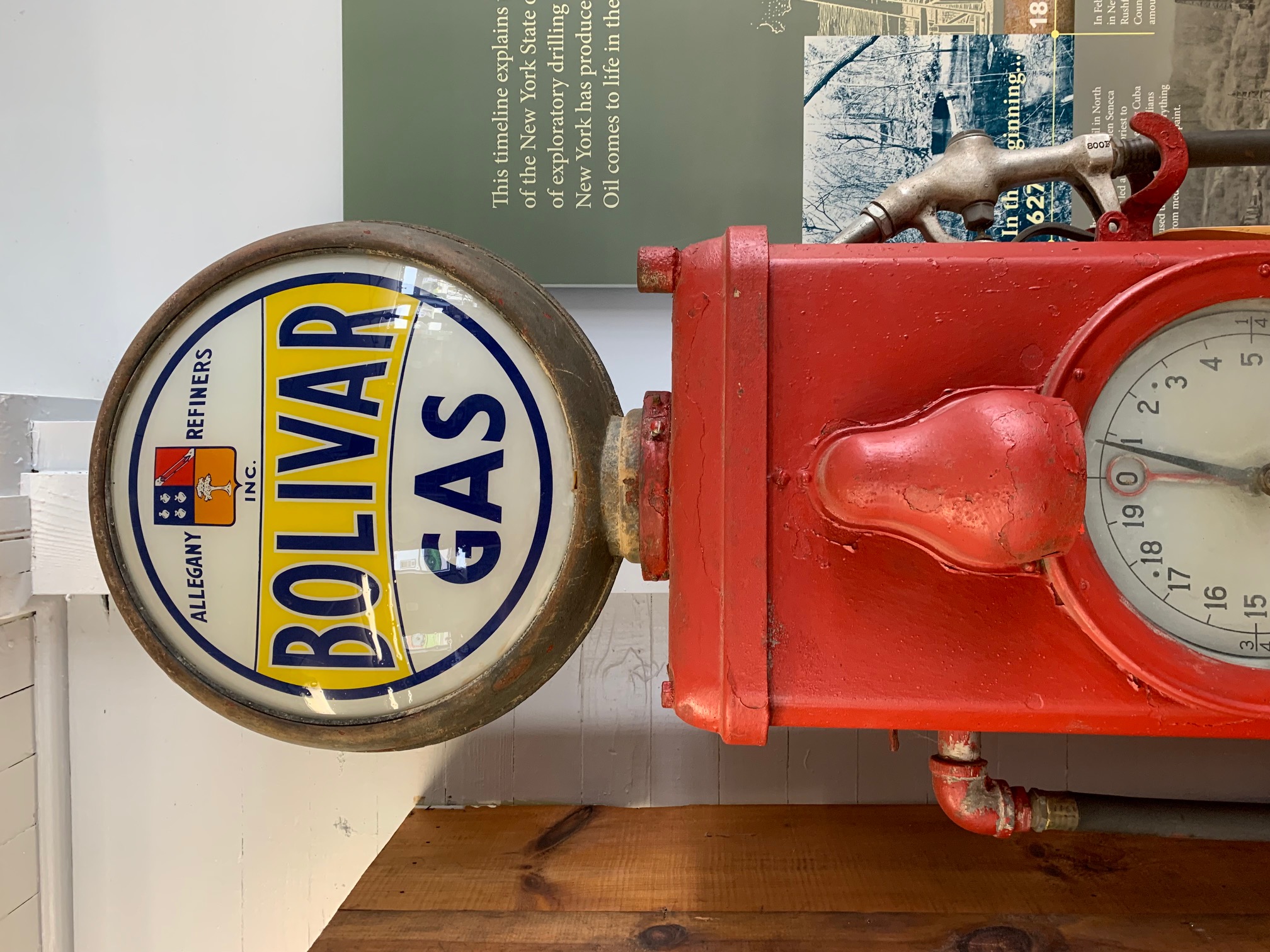
While the state Department of Environmental Conservation did not directly answer how much money would be needed to verify, survey and plug New York wells, it said it is investing in new technologies to help locate unknown wells, such as the drone program.
Even with the new support in the infrastructure package, western New York still faces challenges, as efforts to plug wells in Allegany County and around the Northeast are not always welcome by locals. In Allegany, nostalgia and pride in the industry remain steadfast, and some people hope for the long shot return of the oil industry that built some of these small towns.
The website for Pioneer Oil Museum of New York in Bolivar, a town in Allegany County, reads: “The New York oil fields await new technology to recover the remaining substantial oil reserves.”
The museum documents the oil industry’s influence on Bolivar, which the museum describes as the “heart of the old Allegany Oil Field.” There are enough wells in the area that the museum’s board president, Dan Davison, grew up searching for them in his hometown of Bolivar.
In the winter, former oil roads on his parents’ land became snowmobile tracks. In the summer, Davison would wander in search of signs of the former oil industry: open wells, wells with pumping equipment on them and old engines – all sites now defined as abandoned and unplugged oil wells by the Division of Mineral Resources, which is within the Department of Environmental Conservation and charged with regulating the plugging of oil and gas wells.
“You don’t go very far without seeing remnants of the oil industry,” Davison said. “They’re not bad remnants, there’s just wells here or there.”
Those remnants are not hard to find in Allegany County; derricks greet students at the entrance of Bolivar-Richburg Central School and welcome visitors on town signs.
The wells that once spurred local economies and inspired entire communities lay dormant around the state, in forests, near homes and on farms, each at risk of leaking methane into the atmosphere or directly into homes.
“You could be 18 to 20 inches away from an occupied residence while you’re (plugging a well),” Steve Plants said. Yet, according to the Division of Mineral Resources, anyone who stumbles across an abandoned well should remain a safe distance away: at least 35 feet.
Experts who spoke with City & State all agreed that the ghost of the state’s oil boom must be addressed. Steve Plants characterized funding from the infrastructure package as a “once-in-a-lifetime opportunity to put a dent in the issue.”
So far, the Department of Environmental Conservation identified 140 high-priority wells to plug with the new funding.
“This problem is not going to go away,” Paul Plants said. “It should have been taken care of 50 years ago, and for every year that it waits now, a well that could have been plugged safely at a cheaper rate.
– with reporting by Stephen Mante Anti
Jessie Blaeser and Ilena Peng are pursuing their masters degrees in data journalism at the Columbia University Graduate School of Journalism.
NEXT STORY: The US Cities Most Attractive to Renters





